bonnet FIAT TEMPRA 1988 Service And Repair Manual
[x] Cancel search | Manufacturer: FIAT, Model Year: 1988, Model line: TEMPRA, Model: FIAT TEMPRA 1988Pages: 171, PDF Size: 18.05 MB
Page 5 of 171
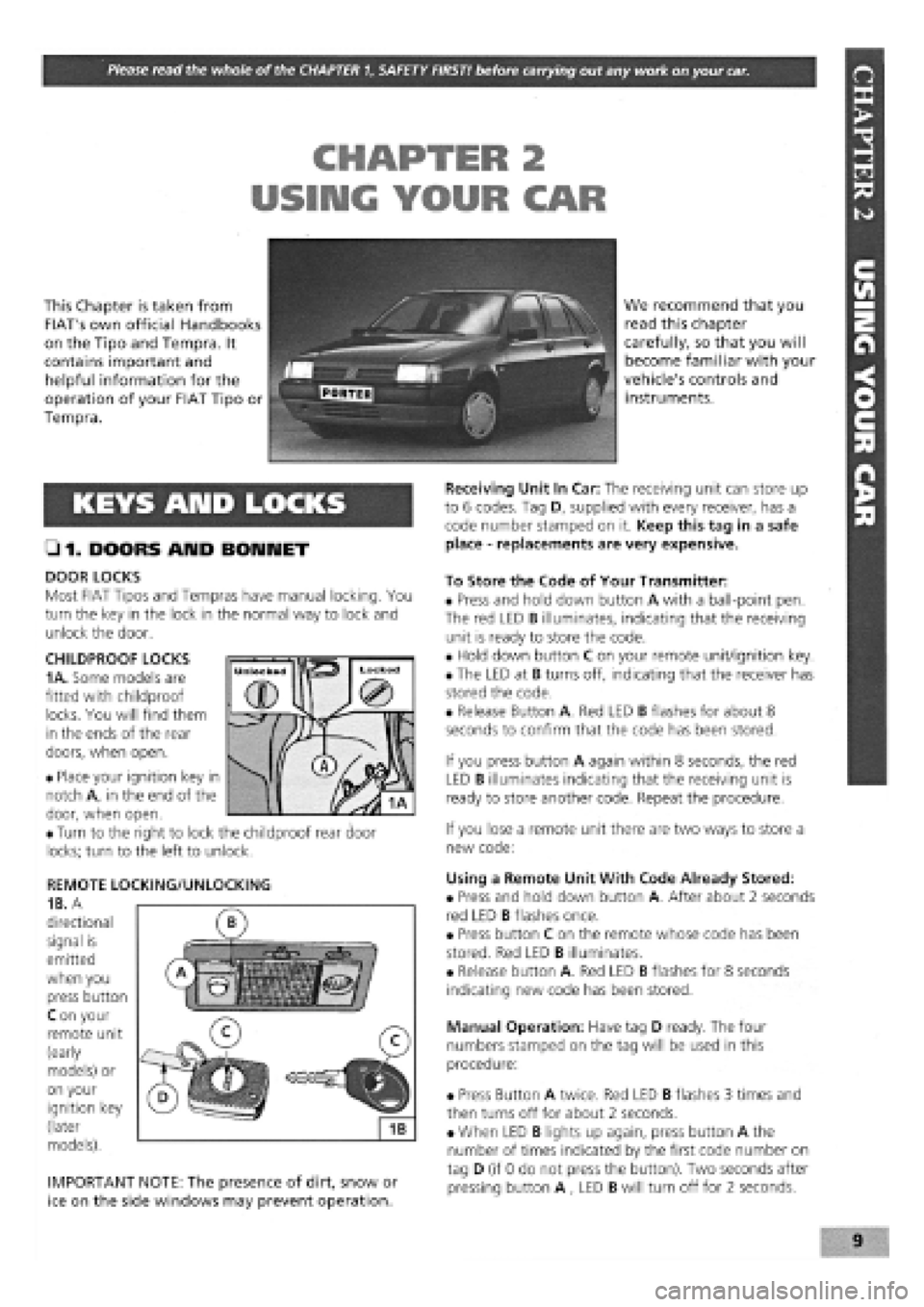
Please read the whole of the CHAPTER 1, SAFETY FIRST! before carrying out any work on your car.
CHAPTER 2
USING YOUR CAR
This Chapter is taken from
FIAT's own official Handbooks
on the Tipo and Tempra. It
contains important and
helpful information for the
operation of your FIAT Tipo or
Tempra.
KEYS AND LOCKS
• 1. DOORS AMD BONNET
DOOR LOCKS
Most FIAT Tipos and Tempras have manual locking. You
turn the key in the lock in the normal way to lock and
unlock the door.
CHILDPROOF LOCKS
1 A.
Some models are
fitted with childproof
locks. You will find them
in the ends of the rear
doors, when open.
• Place your ignition key in
notch A, in the end of the
door, when open.
• Turn to the right to lock the childproof rear door
locks; turn to the left to unlock.
REMOTE LOCKING/UNLOCKING
1B. A
directional
signal is
emitted
when you
press button
C on your
remote unit
(early
models) or
on your
ignition key
(later
models).
IMPORTANT NOTE: The presence of dirt, snow or
ice on the side windows may prevent operation.
We recommend that you
read this chapter
carefully, so that you will
become familiar with your
vehicle's controls and
instruments.
Receiving Unit In Car: The receiving unit can store up
to 6 codes. Tag D, supplied with every receiver, has a
code number stamped on it. Keep this tag in a safe
place
-
replacements are very expensive.
To Store the Code of Your Transmitter:
• Press and hold down button A with a ball-point pen.
The red LED B illuminates, indicating that the receiving
unit is ready to store the code.
• Hold down button C on your remote unit/ignition key.
• The LED at B turns off, indicating that the receiver has
stored the code.
• Release Button A. Red LED B flashes for about 8
seconds to confirm that the code has been stored.
If you press button A again within 8 seconds, the red
LED B illuminates indicating that the receiving unit is
ready to store another code. Repeat the procedure.
If you lose a remote unit there are two ways to store a
new code:
Using a Remote Unit With Code Already Stored:
• Press and hold down button A. After about 2 seconds
red LED B flashes once.
• Press button C on the remote whose code has been
stored. Red LED B illuminates.
• Release button A. Red LED B flashes for 8 seconds
indicating new code has been stored.
Manual Operation: Have tag D ready. The four
numbers stamped on the tag will be used in this
procedure:
• Press Button A twice. Red LED B flashes 3 times and
then turns off for about 2 seconds.
• When LED B lights up again, press button A the
number of times indicated by the first code number on
tag D (if 0 do not press the button). Two seconds after
pressing button A , LED B will turn off for 2 seconds.
Page 11 of 171

SAFETY FIRST!
If an air bag has been fitted to your vehicle:
• DO NOT apply stickers or any other objects to
the steering wheel as this may restrict the
operation of the air bag.
• NEVER travel with anything on your lap or in
front of your chest
• NEVER drive with a cigarette, pipe, pen or any
other object in your mouth.
• 12. INTERIOR LIGHTS
COURTESY LIGHT
On most models the courtesy light is positioned in the
centre of the roof.
• With the light switch in the central position the light
turns on when either of the front doors is opened.
• When the switch is in the right position the light
remains on.
• With the switch in the left position the light is
switched off.
• 13. SUNROOF OPERATION
14B. Positioned at the front of the bonnet is a release
catch B. Lift catch up to release.
14C. Lift the
bonnet and pull
the support rod
C out of its
holder.
When the
• 15. LUGGAGE COMPARTMENT
INCREASING THE CARGO AREA
FOLDING THE BACK SEATS
-
Use the following
procedure to fold the rear seat forwards:
• Pull the strap at the centre of the backseat cushion in
an upwards direction to swing up the seat cushion.
15A. On models fitted with lever A, pull the lever up to
release the seat backrest.
15B. Models fitted with a lockable lever B, turn the key
to position 2 to unlock (1 to lock), then lift the lever in
the direction arrowed.
• Fold the backrest cushion forwards.
BONNET AND LUGGAGE
L 2 . fj§
• 14 .BONNET
OPENING THE BONNET
14A. Pull the bonnet release lever A, toward the
steering wheel to release the bonnet catch.
To repositioning the back seats
-
reverse the order
described above.
WHEEL CHANGING
• 16. CHANGING THE WHEEL IN AN
EMERGENCY
CHANGING A WHEEL
Whenever possible park the car on firm level ground.
Put the car into reverse gear and pull on the handbrake.
Keep chocks or pieces of wood in the boot of your car,
which can be wedged in front and behind the
diagonally-opposite wheel to the one being removed to
prevent the car from rolling. If you haven't got a piece
of wood handy, use large rocks or stones.
The location of the spare wheel, jack and tools for most
models is in the luggage compartment under the mat.
However on some models the spare wheel and tools are
located in a storage container within the side walls of the
rear luggage compartment.
bonnet is fully
raised, place the
tip of the rod in
the recess B located in the bonnet.
• Pull handle A down
and turn anti-clockwise,
slides back.
13B. To operate a
sunroof with
electric controls:
13A. SUNROOF CONTROLS
As an optional extra
some models are fitted
with a sunroof. To
operate the manually
operated sunroof:
The sunroof lifts up and then
• Press rocker
switch C either at
the front or back
edge to open or close the sunroof.
Z3
Page 54 of 171
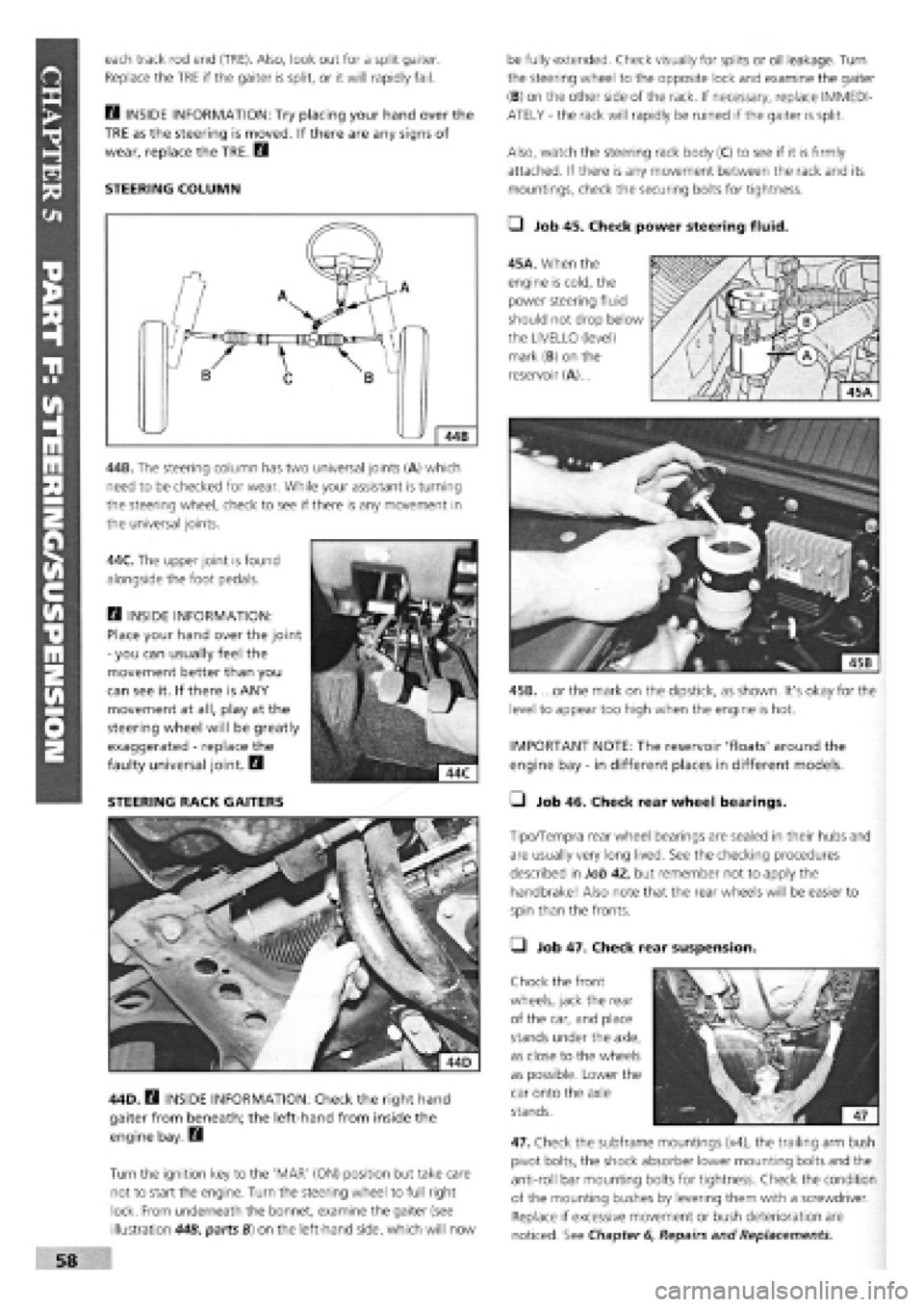
each track rod end (TRE). Also, look out for a split gaiter.
Replace the TRE if the gaiter is split, or it will rapidly fail.
E3 INSIDE INFORMATION: Try placing your hand over the
TRE as the steering is moved. If there are any signs of
wear, replace the TRE. Q
STEERING COLUMN
44B. The steering column has two universal joints (A) which
need to be checked for wear. While your assistant is turning
the steering wheel, check to see if there is any movement in
the universal joints.
44C. The upper joint is found
alongside the foot pedals.
Q INSIDE INFORMATION:
Place your hand over the joint
-
you can usually feel the
movement better than you
can see it. If there is ANY
movement at all, play at the
steering wheel will be greatly
exaggerated
-
replace the
faulty universal joint. B
STEERING RACK GAITERS
44D. B INSIDE INFORMATION: Check the right hand
gaiter from beneath; the left-hand from inside the
engine bay. Q
Turn the ignition key to the 'MAR' (ON) position but take care
not to start the engine. Turn the steering wheel to full right
lock. From underneath the bonnet, examine the gaiter (see
illustration 44B, parts B) on the left-hand side, which will now
be fully extended. Check visually for splits or oil leakage. Turn
the steering wheel to the opposite lock and examine the gaiter
(B) on the other side of the rack. If necessary, replace IMMEDI-
ATELY
-
the rack will rapidly be ruined if the gaiter is split.
Also, watch the steering rack body (C) to see if it is firmly
attached. If there is any movement between the rack and its
mountings, check the securing bolts for tightness.
• Job 45. Check power steering fluid.
45A. When the
engine is cold, the
power steering fluid
should not drop below
the LIVELLO (level)
mark (B) on the
reservoir (A)...
45B. ...or the mark on the dipstick, as shown. It's okay for the
level to appear too high when the engine is hot.
IMPORTANT NOTE: The reservoir 'floats' around the
engine bay
-
in different places in different models.
• Job 46. Check rear wheel bearings.
Tipo/Tempra rear wheel bearings are sealed in their hubs and
are usually very long lived. See the checking procedures
described in Job 42, but remember not to apply the
handbrake! Also note that the rear wheels will be easier to
spin than the fronts.
• Job 47. Check rear suspension.
Chock the front
wheels, jack the rear
of the car, and place
stands under the axle,
as close to the wheels
as possible. Lower the
car onto the axle
stands.
47. Check the subframe mountings (x4), the trailing arm bush
pivot bolts, the shock absorber lower mounting bolts and the
anti-roll bar mounting bolts for tightness. Check the condition
of the mounting bushes by levering them with a screwdriver.
Replace if excessive movement or bush deterioration are
noticed. See Chapter
6,
Repairs and Replacements.
Page 58 of 171
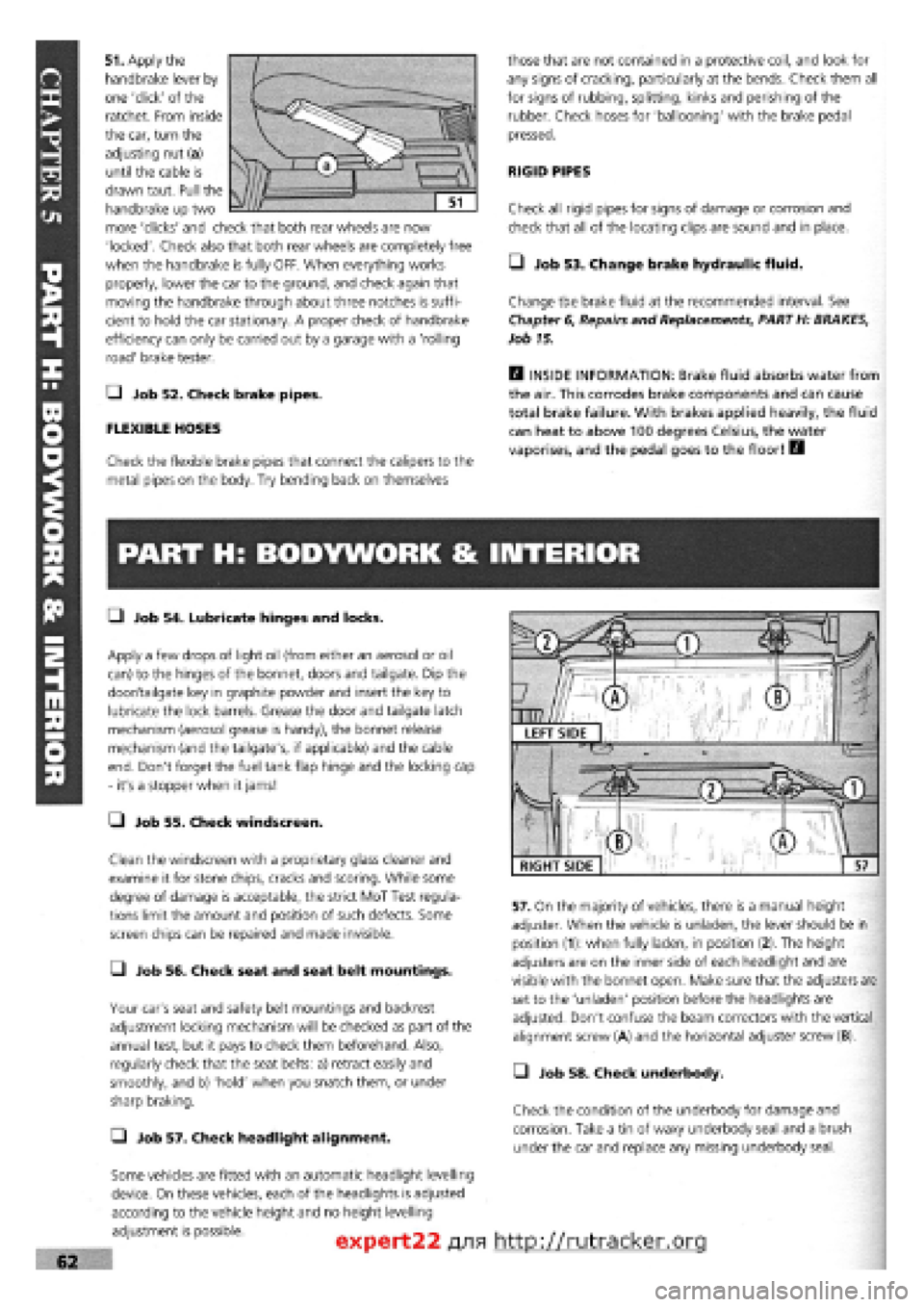
51. Apply the
handbrake lever by
one 'click' of the
ratchet. From inside
the car, turn the
adjusting nut (a)
until the cable is
drawn taut. Pull the
handbrake up two
more 'clicks' and check that both rear wheels are now
'locked'. Check also that both rear wheels are completely free
when the handbrake is fully OFF. When everything works
properly, lower the car to the ground, and check again that
moving the handbrake through about three notches is suffi-
cient to hold the car stationary. A proper check of handbrake
efficiency can only be carried out by a garage with a 'rolling
road' brake tester.
Q Job 52. Check brake pipes.
FLEXIBLE HOSES
Check the flexible brake pipes that connect the calipers to the
metal pipes on the body. Try bending back on themselves
those that are not contained in a protective coil, and look for
any signs of cracking, particularly at the bends. Check them all
for signs of rubbing, splitting, kinks and perishing of the
rubber. Check hoses for 'ballooning' with the brake pedal
pressed.
RIGID PIPES
Check all rigid pipes for signs of damage or corrosion and
check that all of the locating clips are sound and in place.
• Job 53. Change brake hydraulic fluid.
Change the brake fluid at the recommended interval. See
Chapter
6,
Repairs and Replacements, PART H: BRAKES,
Job 15.
H INSIDE INFORMATION: Brake fluid absorbs water from
the air. This corrodes brake components and can cause
total brake failure. With brakes applied heavily, the fluid
can heat to above 100 degrees Celsius, the water
vaporises, and the pedal goes to the floor! B
PART H: BODYWORK & INTERIOR
• Job 54. Lubricate hinges and locks.
Apply a few drops of light oil (from either an aerosol or oil
can) to the hinges of the bonnet, doors and tailgate. Dip the
door/tailgate key in graphite powder and insert the key to
lubricate the lock barrels. Grease the door and tailgate latch
mechanism (aerosol grease is handy), the bonnet release
mechanism (and the tailgate's, if applicable) and the cable
end. Don't forget the fuel tank flap hinge and the locking cap
- it's a stopper when it jams!
• Job 55. Check windscreen.
Clean the windscreen with a proprietary glass cleaner and
examine it for stone chips, cracks and scoring. While some
degree of damage is acceptable, the strict MoT Test regula-
tions limit the amount and position of such defects. Some
screen chips can be repaired and made invisible.
• Job 56. Check seat and seat belt mountings.
Your car's seat and safety belt mountings and backrest
adjustment locking mechanism will be checked as part of the
annual test, but it pays to check them beforehand. Also,
regularly check that the seat belts: a) retract easily and
smoothly, and b) 'hold' when you snatch them, or under
sharp braking.
Q Job 57. Check headlight alignment.
Some vehicles are fitted with an automatic headlight levelling
device. On these vehicles, each of the headlights is adjusted
according to the vehicle height and no height levelling
adjustment is possible.
57. On the majority of vehicles, there is a manual height
adjuster. When the vehicle is unladen, the lever should be in
position (1): when fully laden, in position (2). The height
adjusters are on the inner side of each headlight and are
visible with the bonnet open. Make sure that the adjusters are
set to the 'unladen' position before the headlights are
adjusted. Don't confuse the beam correctors with the vertical
alignment screw (A) and the horizontal adjuster screw (B).
• Job 58. Check underbody.
Check the condition of the underbody for damage and
corrosion. Take a tin of waxy underbody seal and a brush
under the car and replace any missing underbody seal.
expert22 fl/ia http://rutracker.org
RIGHT SIDE
Page 76 of 171
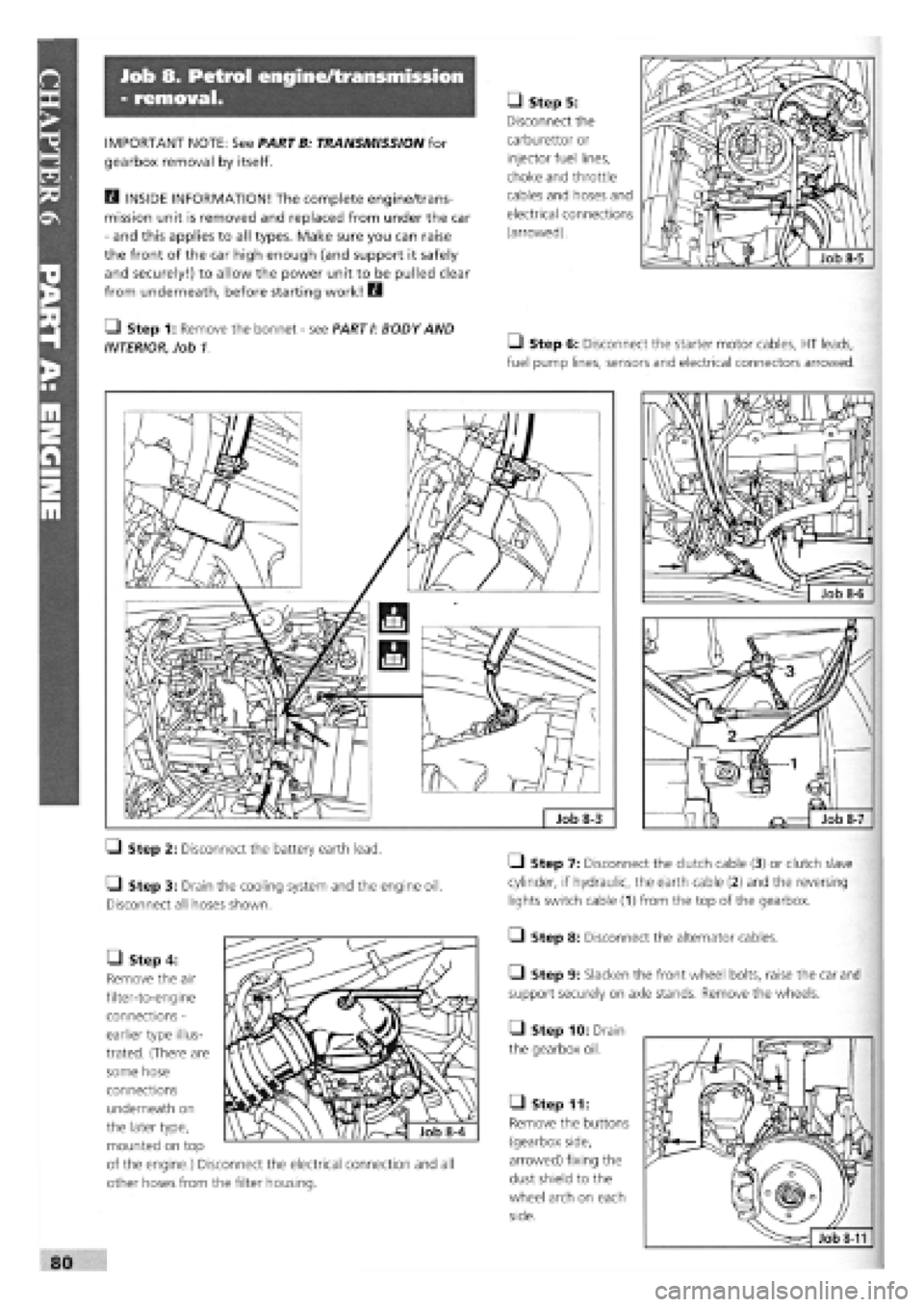
Job 8. Petrol engine/transmission
- removal.
IMPORTANT NOTE: See PARTB: TRANSMISSION for
gearbox removal by itself.
H INSIDE INFORMATION! The complete engine/trans-
mission unit is removed and replaced from under the car
- and this applies to all types. Make sure you can raise
the front of the car high enough (and support it safely
and securely!) to allow the power unit to be pulled clear
from underneath, before starting work! 13
• Step 1: Remove the bonnet
-
see PARTI: BODY AND
INTERIOR, Job 1.
• Step 5:
Disconnect the
carburettor or
injector fuel lines,
choke and throttle
cables and hoses and
electrical connections
(arrowed).
Q Step 6: Disconnect the starter motor cables, HT leads,
fuel pump lines, sensors and electrical connectors arrowed.
Job
8-7
• Step 2: Disconnect the battery earth lead.
• Step 3: Drain the cooling system and the engine oil.
Disconnect all hoses shown.
• Step 7: Disconnect the clutch cable (3) or clutch slave
cylinder, if hydraulic, the earth cable (2) and the reversing
lights switch cable
(1)
from the top of the gearbox.
• Step 8: Disconnect the alternator cables.
Q Step 9: Slacken the front wheel bolts, raise the car and
support securely on axle stands. Remove the wheels.
• Step 10: Drain
the gearbox oil.
• Step 4:
Remove the air
filter-to-engine
connections
-
earlier type illus-
trated. (There are
some hose
connections
underneath on
the later type,
mounted on top
of the engine.) Disconnect the electrical connection and all
other hoses from the filter housing.
• Step 11:
Remove the buttons
(gearbox side,
arrowed) fixing the
dust shield to the
wheel arch on each
side.
Page 89 of 171
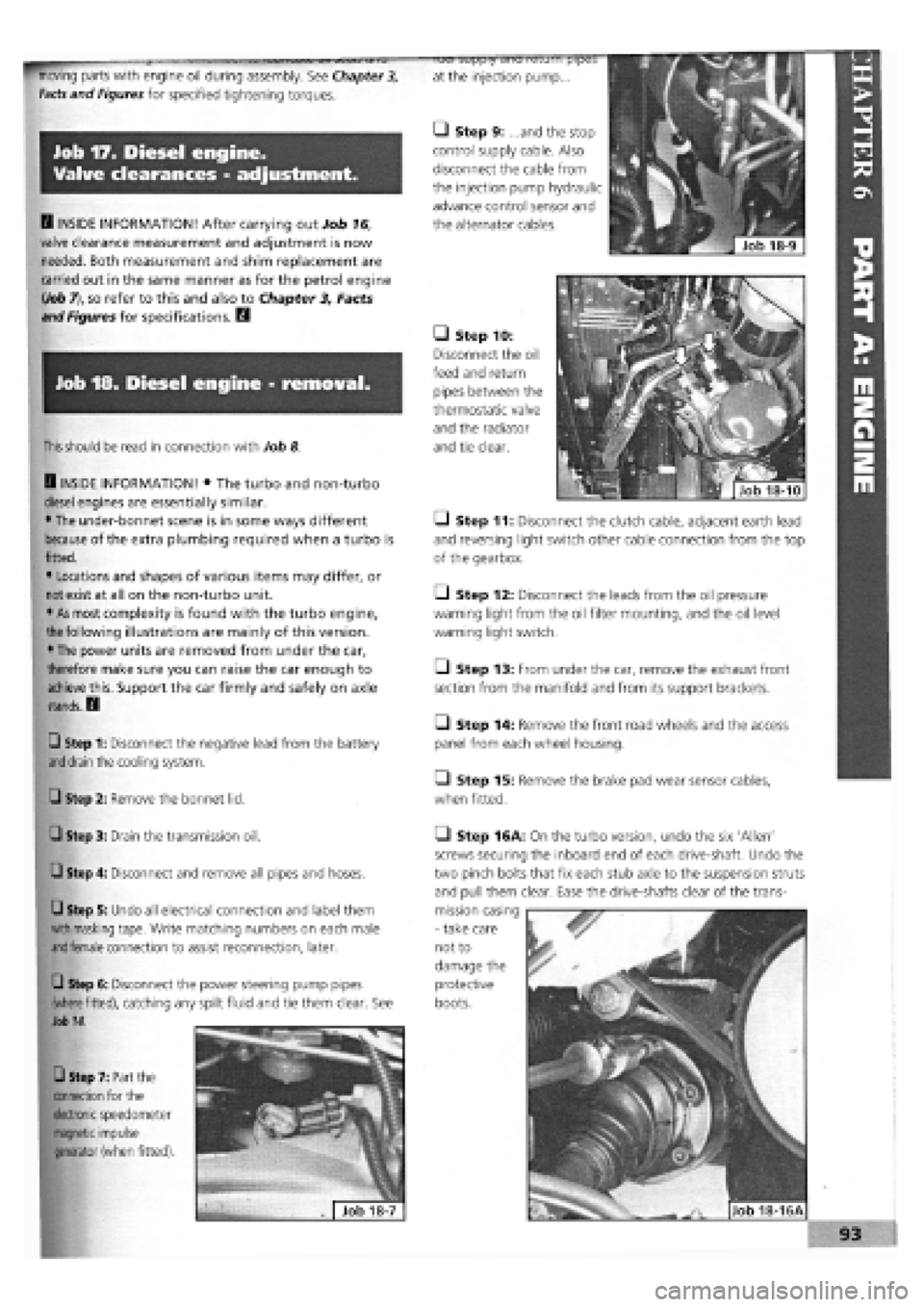
Job 17. Diesel engine.
Valve clearances - adjustment.
D INSIDE INFORMATION! After carrying out Job 16,
valve clearance measurement and adjustment is now
needed. Both measurement and shim replacement are
carried out in the same manner as for the petrol engine
(.Job
7), so refer to this and also to Chapter 3, Facts
and Figures for specifications. B
Job 18. Diesel engine - removal.
moving parts with engine oil during assembly. See Chapter 3,
Facts
and Figures for specified tightening torques.
luei suppiy diiu leium pipe;>
at the injection pump...
• Step 9: ...and the stop
control supply cable. Also
disconnect the cable from
the injection pump hydraulic
advance control sensor and
the alternator cables.
• Step 10:
Disconnect the oil
feed and return
pipes between the
thermostatic valve
and the radiator
and tie clear.
I
This should
be read in connection with Job 8
Q INSIDE INFORMATION! • The turbo and non-turbo
diesel engines are essentially similar.
• The under-bonnet scene is in some ways different
because of the extra plumbing required when a turbo is
fitted.
• Locations and shapes of various items may differ, or
not exist at all on the non-turbo unit.
• As most complexity is found with the turbo engine,
I
the
following illustrations are mainly of this version.
• The power units are removed from under the car,
therefore make sure you can raise the car enough to
achieve this. Support the car firmly and safely on axle
stands. D
Q Step 1: Disconnect the negative lead from the battery
and drain
the cooling system. Q Step 2: Remove the bonnet lid.
• Step 3: Drain the transmission oil.
Q Step 4: Disconnect and remove all pipes and hoses.
Q Step 5: Undo all electrical connection and label them
with masking
tape. Write matching numbers on each male
and female
connection to assist reconnection, later.
Q Step 6: Disconnect the power steering pump pipes
(where fitted),
catching any spilt fluid and tie them clear. See
Job 14.
• Step 7: Part the
connection for the
electronic
speedometer
magnetic impulse
generator
(when fitted).
Q Step 11: Disconnect the clutch cable, adjacent earth lead
and reversing light switch other cable connection from the top
of the gearbox.
• Step 12: Disconnect the leads from the oil pressure
warning light from the oil filter mounting, and the oil level
warning light switch.
• Step 13: From under the car, remove the exhaust front
section from the manifold and from its support brackets.
O Step 14: Remove the front road wheels and the access
panel from each wheel housing.
• Step 15: Remove the brake pad wear sensor cables,
when fitted.
Q Step 16A: On the turbo version, undo the six 'Allen'
screws securing the inboard end of each drive-shaft. Undo the
two pinch bolts that fix each stub axle to the suspension struts
and pull them clear. Ease the drive-shafts clear of the trans-
mission casing
-
take care
not to
damage the
protective
boots.
Page 95 of 171

• Step 2: Remove the bonnet. Disconnect and remove the
battery.
0 Step 3: Drain the oil from the transmission.
0 Step 4: Disconnect the clutch cable or remove the slave
cylinder, if hydraulic, from the top of the gearbox.
• Step 13: Disconnect the
gearchange rods at the gearbox
(arrowed).
O Step 14: Remove the trans-
mission mounting and bracket
assembly.
Job 2. Transmission refitting
(with engine in car).
/ a 5tep1S: • SLjpp°n the
'' £/ gearbox in such a way that
when disconnecting, it can
be withdrawn smoothly and without 'hanging' on the
engine. A trolley jack might do the job nicely.
• Step 16:
Undo the gearbox
to engine fixing
bolts...
• Step 17: ...slide the
box back until it's clear of
the clutch and lower it to
the ground using a
hydraulic stand or trolley
jack.
IMPORTANT NOTE: Refer to PART A: ENGINE, Jobs 8
and 9 in connection with this Job.
• Step 1: Refitting is the reverse of the removal work
carried out in Job 1 but bear in mind the following:
Q Step 2: Centralise the clutch driven plate, if it has been
disturbed. See Job 3.
• Step 3: NON-HYDRAULIC CLUTCHES ONLY. Adjust the
clutch cable. See Job 4
Q Step 6: Raise the front of the car and support securely on
axle stands.
Remove the road wheels and the previously
slackened hub nuts.
Q Step 7: Remove the wheel arch protective shields.
Q Step 8: Disconnect the speedometer cable from the
gearbox. (If digital instrumentation, disconnect the wiring
from
the sender unit.)
Q Step 9: Disconnect and remove the starter motor and
unplug
the reverse light connector and the earth lead from
the
transmission housing.
Q Step 10: Undo the trackrod ends securing nuts and use a
suitable 'splitter' tool to part the balljoints from the steering
arms.
Slacken the drive-shaft inner boot securing clips. Undo
the pinch
bolts fixing the stub axles to the suspension struts,
pull
the stub axles clear and extract the drive-shafts.
0 Step 11: Support the engine at the gearbox end, just
taking
the weight as described in Step 1.
Q Step 12: Remove the central power unit support (a), the
flywheel guard (b) and the exhaust bracket (c).
• Step 5: With
the
car
still
on the
ground, loosen
the nuts
fixing the
constant velocity
joints
to the hubs.
These require an
enormous force
to be
tightened or
released (see
Chapter 3,
Facts and Figures) and they will have been
staked. There is a severe risk of pulling the car off supports if
you
attempt to undo these nuts while the car is raised off the
ground. Slacken the front wheel nuts.
Job 1-14
Page 97 of 171
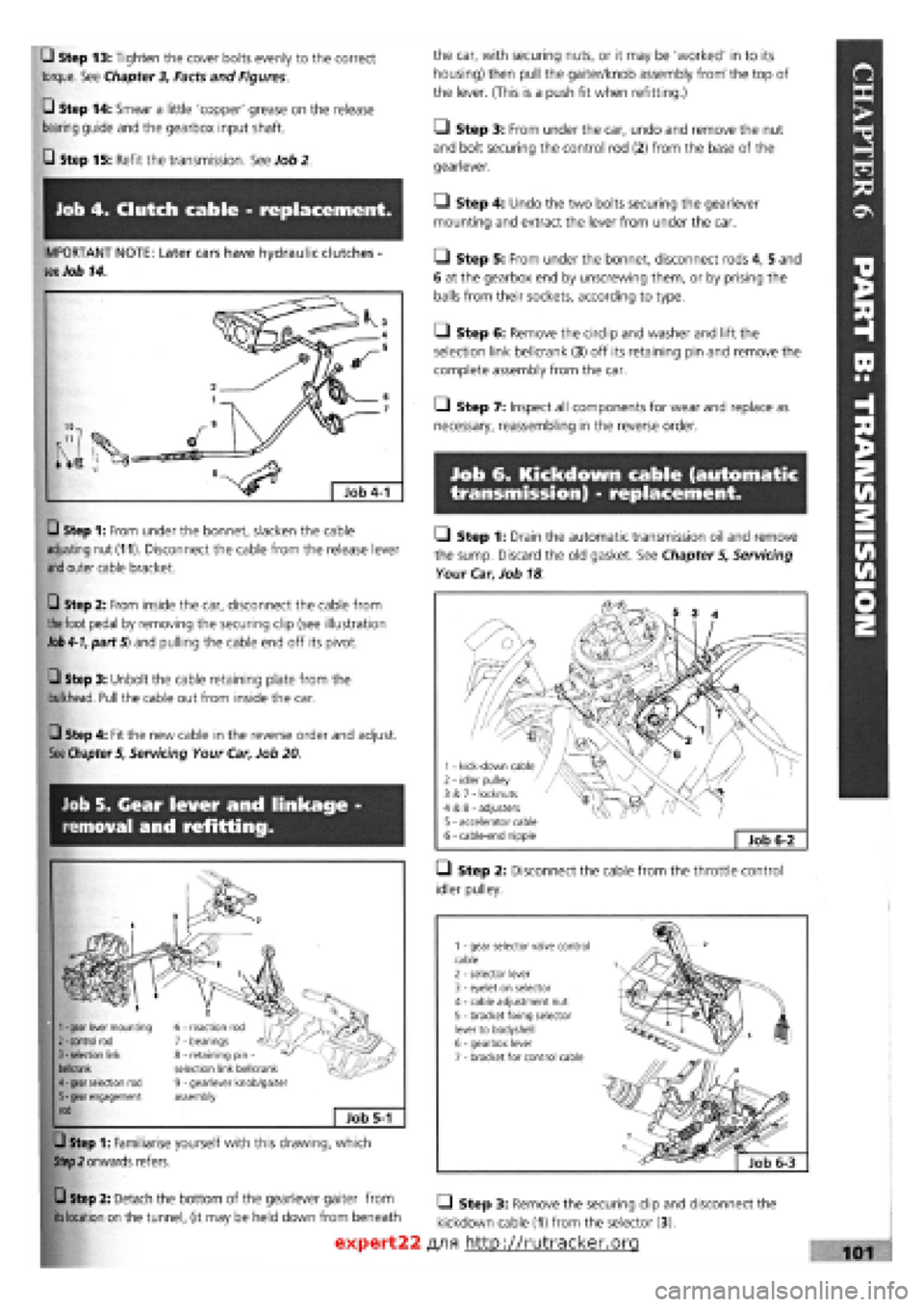
• Step 13: Tighten the cover bolts evenly to the correct
torque. See Chapter
3,
Facts and Figures.
G Step 14: Smear a little 'copper' grease on the release
bearing guide and the gearbox input shaft.
G Step 15: Refit the transmission. See Job 2.
lob 4. Clutch cable - replacement.
IMPORTANT NOTE: Later cars have hydraulic clutches
see Job 14.
• Step 1: From under the bonnet, slacken the cable
adjusting nut (11). Disconnect the cable from the release lever
and
outer cable bracket.
the car, with securing nuts, or it may be 'worked' in to its
housing) then pull the gaiter/knob assembly from the top of
the lever. (This is a push fit when refitting.)
IG Step 3: From under the car, undo and remove the nut
and bolt securing the control rod (2) from the base of the
gearlever.
• Step 4: Undo the two bolts securing the gearlever
mounting and extract the lever from under the car.
Q Step 5: From under the bonnet, disconnect rods 4, 5 and
6 at the gearbox end by unscrewing them, or by prising the
balls from their sockets, according to type.
Q Step 6: Remove the circlip and washer and lift the
selection link bellcrank (3) off its retaining pin and remove the
complete assembly from the car.
• Step 7: Inspect all components for wear and replace as
necessary, reassembling in the reverse order.
Job 6. Kickdown cable (automatic
transmission) - replacement.
Q Step 1: Drain the automatic transmission oil and remove
the sump. Discard the old gasket. See Chapter
5,
Servicing
Your Car, Job 18
G Step 2: From inside the car, disconnect the cable from
the foot
pedal by removing the securing clip (see illustration
Job 4-1,
part 5) and pulling the cable end off its pivot.
G Step 3: Unbolt the cable retaining plate from the
bulkhead. Pull the cable out from inside the car.
G Step 4: Fit the new cable in the reverse order and adjust.
See Chapter 5,
Servicing Your Car, Job 20
Job 5. Gear lever and linkage -
removal and refitting.
1
-
gear lever mounting 6 - reaction rod 2
•
control rod 3-selection link bellcrank 4
-
gear selection rod 5
-
gear engagement rod
7 - bearings 8 - retaining pin -selection link bellcrank 9 - gearlever knob/gaiter assembly
Job 5-1
^ Step 1: Familiarise yourself with this drawing, which
Step 2
onwards refers. n
J Step 2: Detach the bottom of the gearlever gaiter from
its location
on the tunnel, (it may be held down from beneath
expert22
f:
1 - kick-down cable 2 - idler pulley 3 & 7 - locknuts 4 & 8 - adjusters 5 - accelerator cable 6 - cable-end nipple Job 6-2
• Step 2: Disconnect the cable from the throttle control
idler pulley.
1 - gear selector valve control cable 2 - selector lever 3 - eyelet on selector 4 - cable adjustment nut 5 - bracket fixing selector lever to bodyshell 6 - gearbox lever 7 - bracket for control cable
Q Step 3: Remove the securing clip and disconnect the
kickdown cable (1) from the selector (3).
fl/ifl http://rutracker.org
Page 103 of 171

Job 5. Coolant pump -
replacement.
L) Step 4: Lower the switch into water until the thread is
just
covered and the terminals remain dry.
G Step 5: Heat the water slowly. The bulb should light just
below boiling point (90 to 94 degrees Celsius) and go out
when
the temperature falls below 85 to 89 degrees Celsius.
G Step 6: Refit with a new O-ring but do not over tighten.
Job 4. Thermostat - replacement.
G Step 1: Drain the cooling system.
G Step 2: Disconnect the hoses from the thermostat
housing. Illustration Type 1, part 4 (petrol), or Type 2, part
6 (diesel). Undo the bolts and remove the housing/thermostat
assembly.
G Step 3: Clean the mating surfaces, fit the new unit with a
new
gasket.
G Step 4: Reconnect the hoses and refill the cooling system
with
the correct 50/50 FL 'Paraflu' anti-freeze mixture. See
Chapter
5, Servicing Your Car.
E9 INSIDE INFORMATION! For location of the water pump,
see illustration Type 1 (petrol), or Type 2 (diesel). B
• Step 1: Raise the bonnet and drain the cooling system.
Remove the air cleaner.
• Step 2: Unplug the alternator leads, slacken the bolts and
remove the drive belt. Remove the alternator.
• Step 3: Disconnect the hoses and the metal transfer pipe
from the pump.
• Step 4: Undo the securing bolts and remove the coolant
pump.
• Step 5: Discard the old gasket and clean off the mating
surfaces.
Q Step 6: Refit in reverse order using a new gasket.
• Step 7: Adjust the drivebelt tension. See Chapter 5,
Servicing Your Car.
• Step 8: Fill the cooling system with the correct 50/50
solution of FL 'Paraflu' anti-freeze solution. See Chapter 3,
Facts and Figures.
PART D: IGNITION SYSTEMS
——
PART D: Contents
Job 1. Ignition component positions. Job 4. Distributor
-
removal and refitting (1.6 litre engine).
Job
2.
Ignition coil
-
replacement. Job 5. Electronic ignition.
Job
3.
Distributor
-
removal and refitting (1.4 litre engine).
Job 1. Ignition component
positions.
washer g - distributor spacer Job 1-2B
G Point 1: Take note of the positions of the major ignition
components.
Q Point 2B: These are the 1.6 ignition components. Later
models had the coil integral with the distributor.
o
a
>
H
w
w
ON
(A
H
ri
S
VI
107
G Point 2A: This is the 1.4 system, from 1993-on. Earlier
components are in the same positions.
a
-
distributor b
-
ignition coil ^ c-HT leads ^ d
-
clamp with bolt and washer e
-
plug f
-
HT lead support g
-
distributor spacer
Job 1-2 A
Page 107 of 171

Job 6. Hatchback wiper motor -
replacement.
• Step 3: Disconnect the drive cable from the back of
speedometer.
• Step 4: From under the bonnet, uncouple the two cable
halves
from the centre connector and withdraw the
speedometer section through the bulkhead.
Q Step 5: Disconnect the lower end of the cable from the
gearbox drive and remove it.
G Step 6: Follow the reverse procedure to refit the cable,
being
careful to run the cable as straight as possible, avoiding
sharp bends.
Job 5. Windscreen wiper motor -
replacement.
Q Step 1: Disconnect the battery negative (earth) terminal.
Q Step 2: Note the position of the wiper blades on the
screen. Remove the two windscreen wiper arms and then the
grille
cover.
Q Step 3: Unplug the electrical connector and undo the
four mounting screws (arrowed). Remove the complete
assembly.
Q Step 4: Uncouple the linkage rods from the motor
(arrowed).
Q Step 5: Remove the motor by undoing the three
mounting bolts.
Q Step 6: Note the location of
-
and wiring for
-
these
components.
Q Step 7: Refitting is the reverse of removal, but take care
to position
the wiper arms as you found them after first
making
sure the motor is 'parked'.
IMPORTANT NOTE: For a view of the headlight wiper
motor (where fitted) refer to Job 7. Step 3.
PART A: TIPO MODELS
• Step A1: This
is a view of the
components for
the Tipo rear
wiper.
• Step A2:
Undo the securing
nut and remove
the wiper arm.
• Step A3: Open the tailgate and pull the weather strip
away from the top of the interior trim panel.
• Step A4: Remove the five screws holding the trim in
place
-
three of these also secure the lock.
Q Step A5: Carefully lever out the trim fixing clips freeing
the trim. Unplug the wiring to the tailgate lock motor (if fitted)
and remove the lock/trim panel assembly.
• Step A6: Unplug the wires from the wiper motor, undo
the three screws holding the motor in place and remove the
motor assembly.
• Step A7: Check that the seal in the tailgate wiper shaft
hole is in good condition and then start refitting in reverse
order. Make sure the wiper motor is 'parked' before fitting the
arm and blade.
PART B: TEMPRA MODELS
• Step B1: This shows the layout of the Tempra rear wiper.
Q Step B2: Disconnect the
battery earth lead. Undo the
securing nut and remove the
wiper arm.
Q Step B3: Remove the
motor cover shield.
Q Step B4: Disconnect the
wiring plug and washer
tubing.
• Step B5: From outside,
undo and remove the wiper
shaft nut and retrieve the spacer/seal.